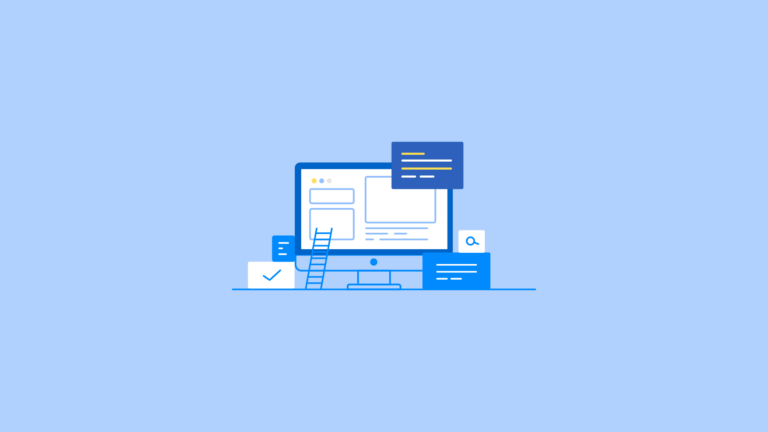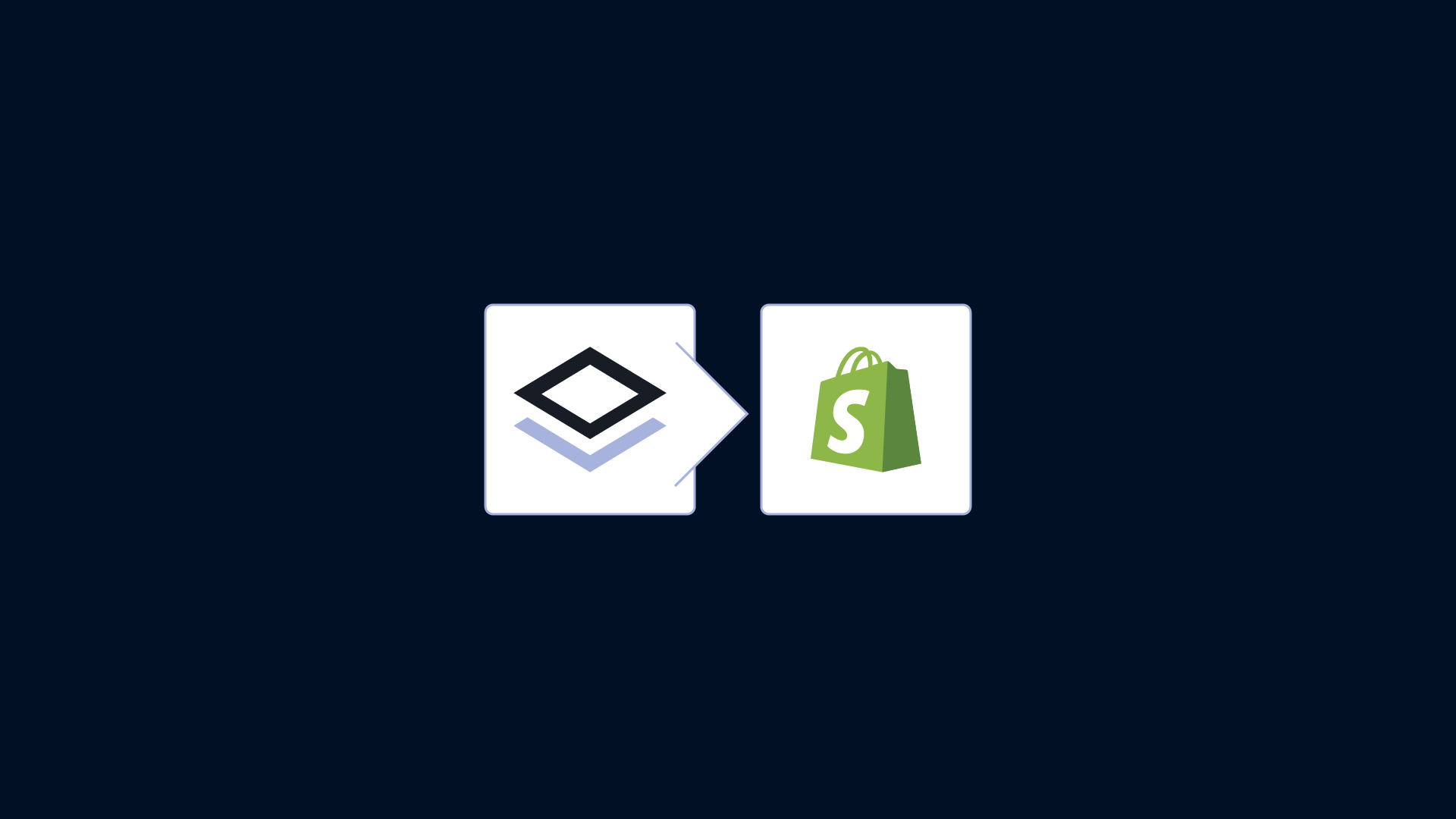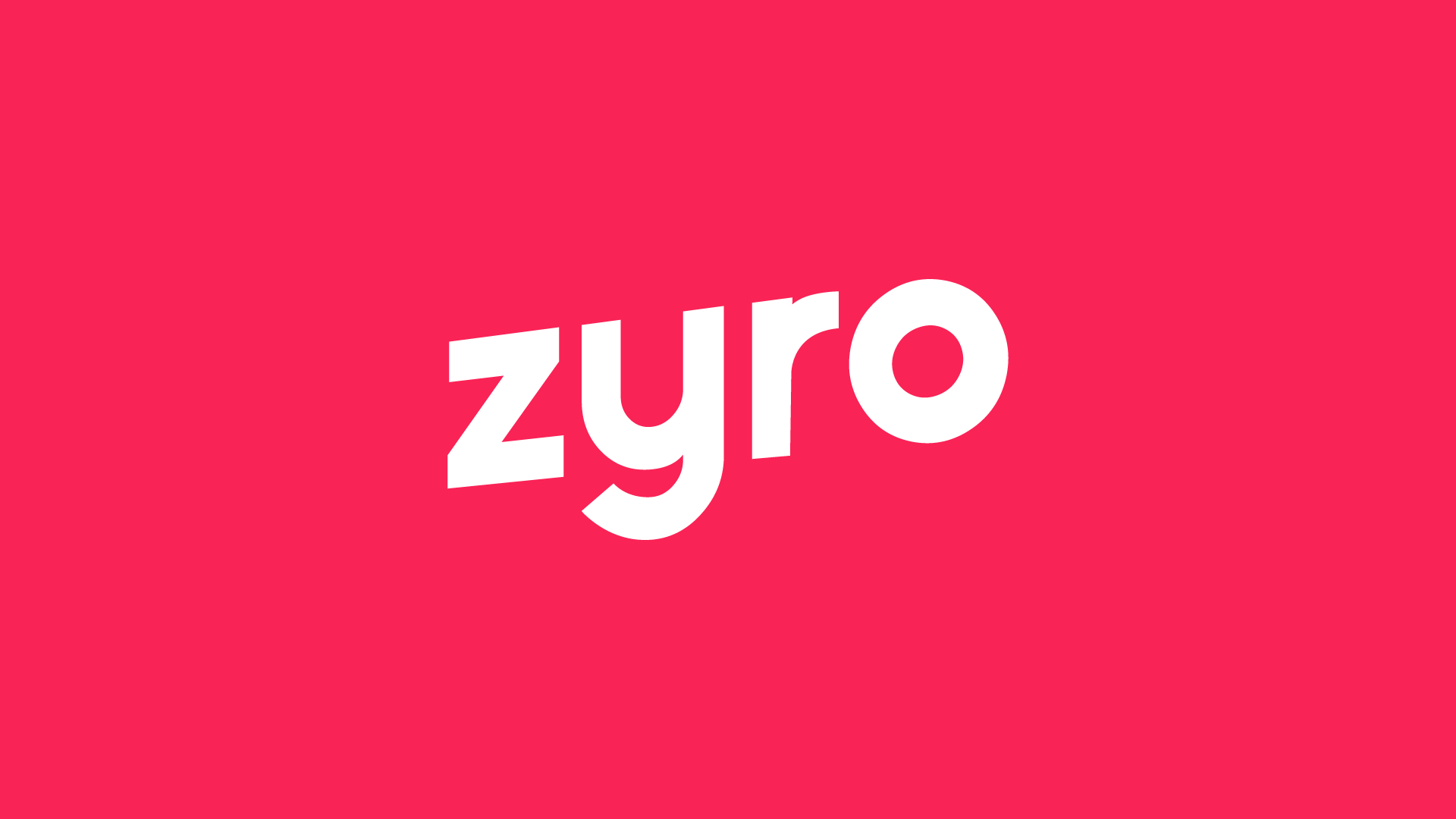|
Getting your Trinity Audio player ready...
|
There are various methods for creating a website, with website builders and WordPress being among the simpler options. For individuals who are not experienced with technology, using a website builder like Wix, Squarespace, Shopify, or GoDaddy may be the most appropriate option. Already in 2023, 18 million websites have been built using a website builder.
Whether you’re a seasoned professional or an absolute beginner, there are two main methods for creating your site. The first, a website builder, will likely be the better option for those looking to keep their costs low and their learning curve mild. These platforms provide hosting services already included in their subscription fees, eliminating extra expenses one might incur with WordPress.
In this step-by-step guide, we will walk you through the process of building a website using a website builder. We’ll explore the key considerations, and the fundamental steps involved, and provide practical tips to help you create a stunning and functional website that aligns with your goals and vision.
Build a Website Using a Website Builder
Here is how you can get started building a website using a website builder:
1. Choose the Right Website Builder For Your Brand
The best website builder software comes with templates that help speed up the creation process, giving you plenty of options when it comes to designing your site. By taking advantage of these existing designs, you can quickly apply customizations such as changing background images and choosing colors and typography that reflect your brand identity.
For those who want even deeper control over their site’s look and feel, some builders offer code editing which makes it possible to fine-tune any factor of the design without needing any technical expertise. With easy-to-use features like drag-and-drop navigation capabilities making changes has never been simpler or more intuitive.
Here are some tips you can use to choose the right website builder for you.
What is the Best Website Builder to Use?
Choosing the best website builder depends on your specific needs and preferences. There are several popular website builders available, each with its own set of features, templates, ease of use, and pricing plans.
Here are a few top website builders that you can consider:

- Wix: Wix is a user-friendly website builder known for its drag-and-drop interface and a wide range of professionally designed templates. It offers extensive customization options, a robust app market for additional functionality, and a free plan with limited features.
- Squarespace: Squarespace is renowned for its visually stunning templates, making it an excellent choice for creative professionals and businesses. It offers a user-friendly editor, built-in e-commerce functionality, and reliable hosting. Squarespace has slightly higher pricing compared to some other builders.
- Hostinger Website Builder(Formerly Zyro): Hostinger’s website builder is a beginner-friendly tool that allows you to create a website quickly and easily. It provides a drag-and-drop editor, a variety of professionally designed templates, and customization options. Hostinger’s website builder is integrated with their hosting services, offering a seamless experience for managing your website and hosting in one place.
- Shopify: Shopify is specifically designed for building e-commerce websites. It provides a comprehensive platform with powerful e-commerce features, secure payment gateways, inventory management, and more. While primarily focused on online stores, it can be used for other types of websites as well.
- Weebly: Weebly offers an intuitive drag-and-drop website builder with a good selection of templates. It provides easy integration with third-party tools, built-in SEO features, and e-commerce functionality. Weebly is known for its beginner-friendly interface and affordable pricing plans.
It’s important to consider factors such as your technical expertise, desired website functionality, scalability, budget, and the specific requirements of your project. Take advantage of free trials or demos offered by website builders to test their features and determine which one aligns best with your needs.
2. Getting Started with a Website Builder
After choosing a website builder, the next step is to sign up for a suitable plan that aligns with your specific requirements. Website builders typically offer multiple plans to cater to different needs, ensuring that you only pay for the features and tools you actually need.
The pricing of website builder plans can vary but generally falls within the range of $8 to $40 per month, offering an all-inclusive package. If you have budget constraints, you have a couple of options.
You can either stick with a free plan, although it’s important to note that free plans may come with certain limitations and disadvantages which we’ll discuss shortly. Alternatively, you can explore our recommendations for the most affordable plans available.
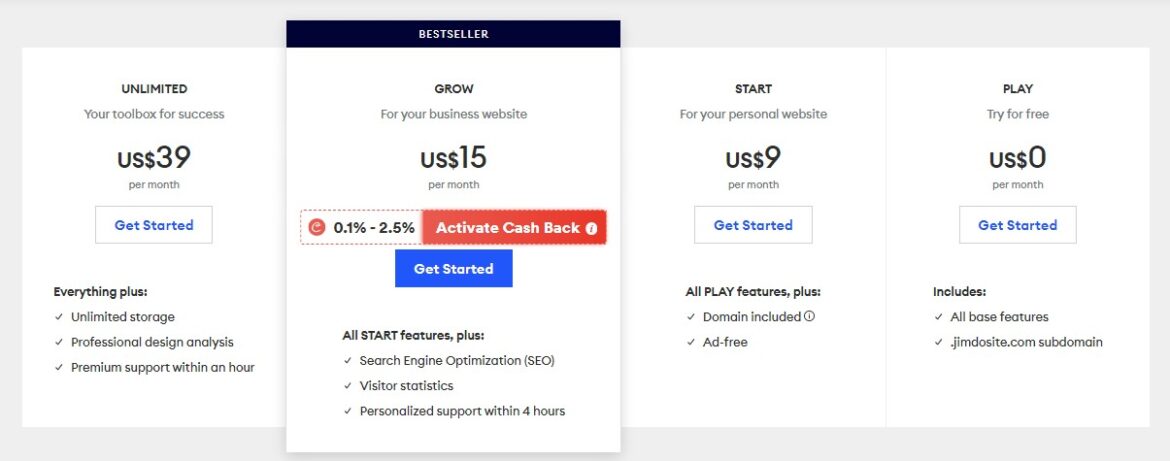
The cost-effectiveness of website builders is a major advantage when compared to hiring a web developer. Hiring a developer for template customization alone can range from $300 to $1,000, and a fully customized website built from scratch often runs into thousands of dollars. By using a website builder, you have the opportunity to create a fully functional website at a fraction of the cost, sometimes even less than the price of a cup of coffee.
The choice of website builder and plan ultimately depends on your specific needs and preferences. Consider the features, customization options, support, and pricing of different plans to select the one that best fits your requirements.
When getting started with building your website, one of the important factors to consider is the pricing options offered by different website builders.
Here’s an overview of the pricing options for some popular website builders:
Wix
- Free Plan: Wix offers a free plan that allows you to create a basic website with Wix branding and limited features.
- Premium Plans: Wix offers various premium plans starting at around $14 per month, which provide additional features such as a custom domain, more storage, advanced design options, and e-commerce capabilities.
- Dedicated eCommerce plans start from $27 per month.
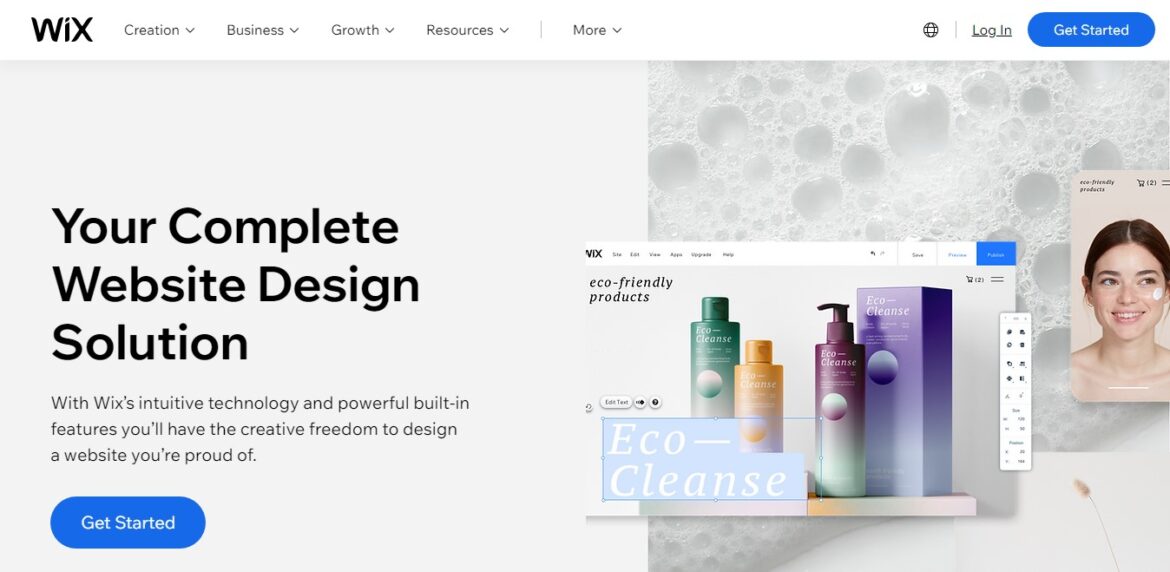
Squarespace:
- Personal Plan: Squarespace offers a Personal plan at around $16 per month, billed annually. This plan includes a free custom domain, unlimited bandwidth and storage, and basic website metrics.
- Business and Commerce Plans: Squarespace offers higher-tier plans starting at around $23 per month, providing additional e-commerce features, marketing tools, and advanced analytics.
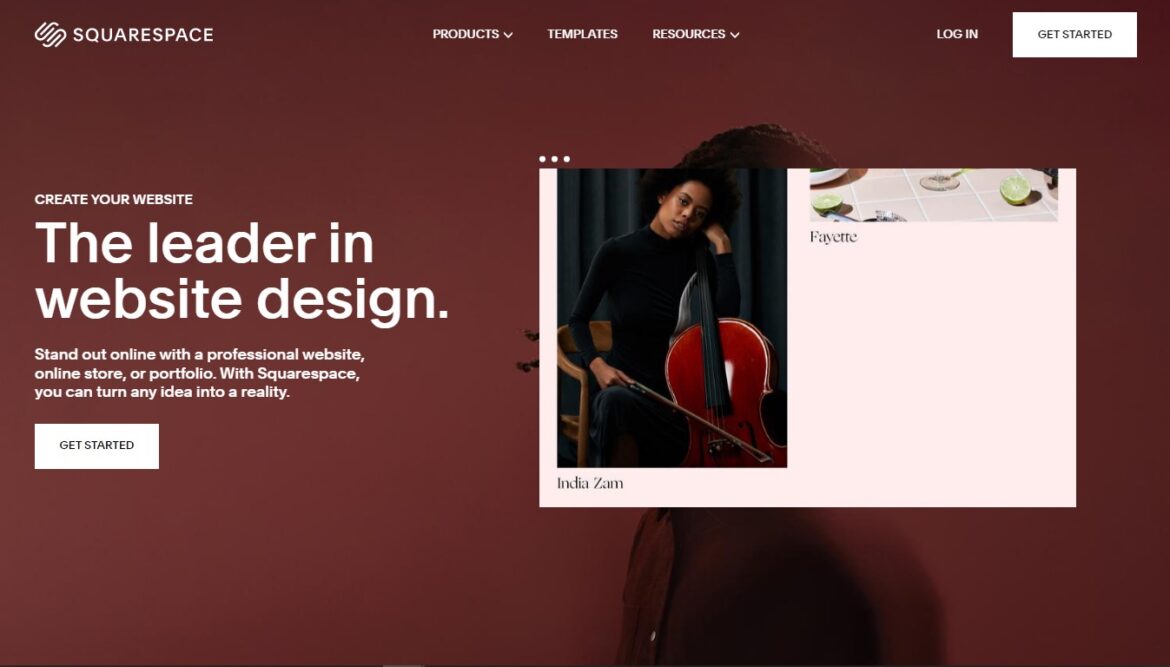
Hostinger Website Builder:
- Single, Premium, and Business Plans: Hostinger’s website builder is available as part of their hosting plans. The Single plan starts at around $1.99 per month and includes one website, while the Premium and Business plans offer additional features such as unlimited websites, free domain registration, and enhanced performance.
- Hostinger offers more than just a website builder. You get a free domain, Free email, eCommerce features, marketing integrations, and free web hosting. Ai can also build for you powered by chatGPT.
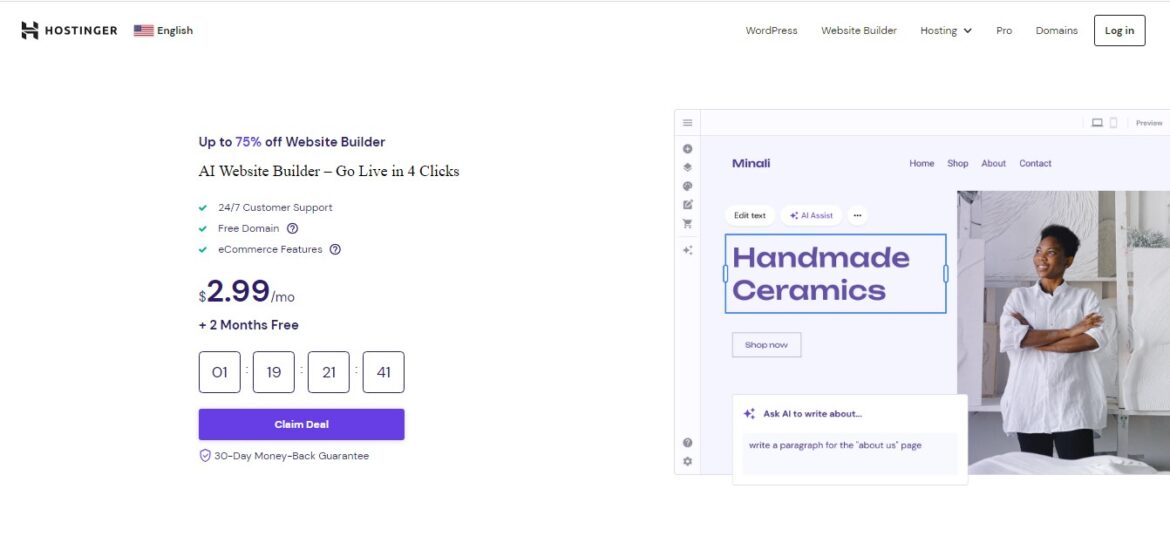
Shopify:
- Basic Shopify: Shopify offers a Basic plan at around $29 per month, which provides essential features for starting an online store, including unlimited products, 24/7 support, and sales channels.
- Shopify and Advanced Shopify: Shopify offers higher-tier plans starting at around $79 per month, which include additional features like advanced reporting, third-party shipping calculations, and more.

Weebly:
- Free Plan: Weebly offers a free plan with basic features and a Weebly subdomain.
- Connect, Pro, and Business Plans: Weebly’s premium plans start at around $10 per month, offering features such as a custom domain, expanded storage, and advanced site stats. The Business plan includes e-commerce functionality.
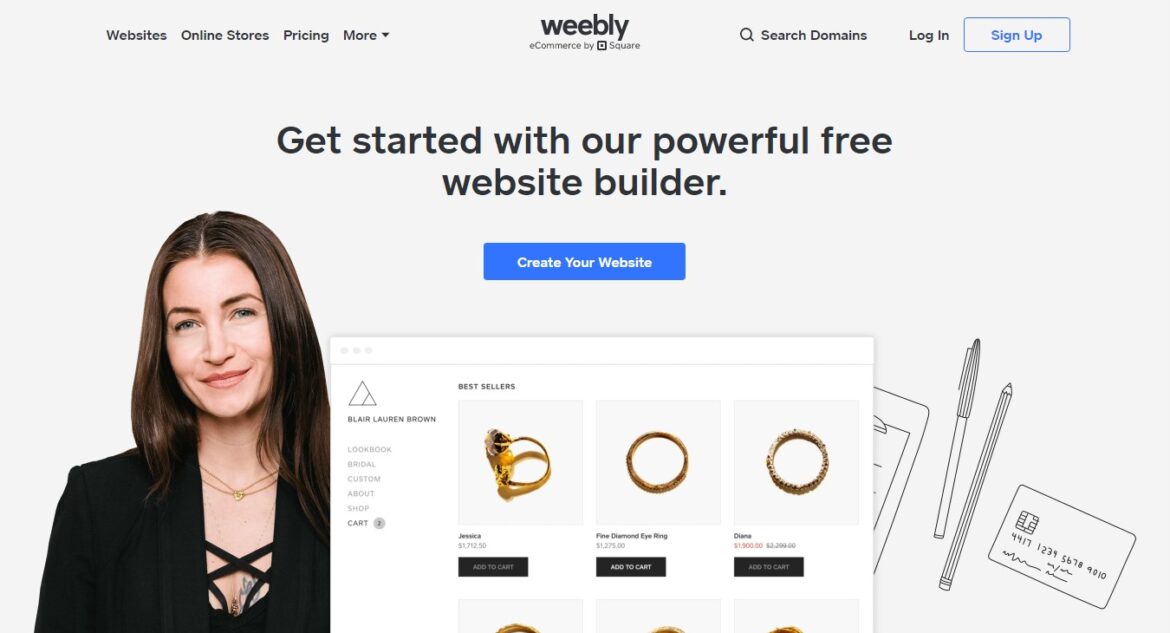
Remember to review the specific features and limitations of each pricing plan offered by the website builders to choose the one that best suits your budget and requirements. The next steps will be the following:
- Sign up for an account: Visit the website builder’s official website and create an account by providing the necessary information.
- Choose a template or theme: Choose a template that suits the nature and style of your website. Most website builders offer a wide range of professionally designed templates to choose from.
- Customize the design and layout: Personalize your website by customizing the chosen template. Modify colors, fonts, images, and layouts to reflect your brand identity or desired aesthetic.
3. Adding Content: Crafting Compelling Web Pages
When it comes to building a website, compelling content plays a vital role in engaging your visitors and conveying your message effectively. Let’s explore the process of creating and organizing web pages, writing engaging copy, incorporating multimedia elements, and leveraging widgets and plugins to enhance functionality.
Here is how you go about setting your website for success:
First, plan your website structure
Website content doesn’t just go into the website to be scattered, your need to build an structure your website visitors and customers will understand and easily navigate. To achieve this:
- Determine the main pages: Identify the key pages your website needs, such as Home, About, Services, Products, and Contact.
- Organize content hierarchically: Structure your website in a logical manner, using categories, subpages, and menus to make navigation intuitive for visitors.
- Consider user experience(UX): Think about the flow of information and ensure visitors can easily find what they are looking for.
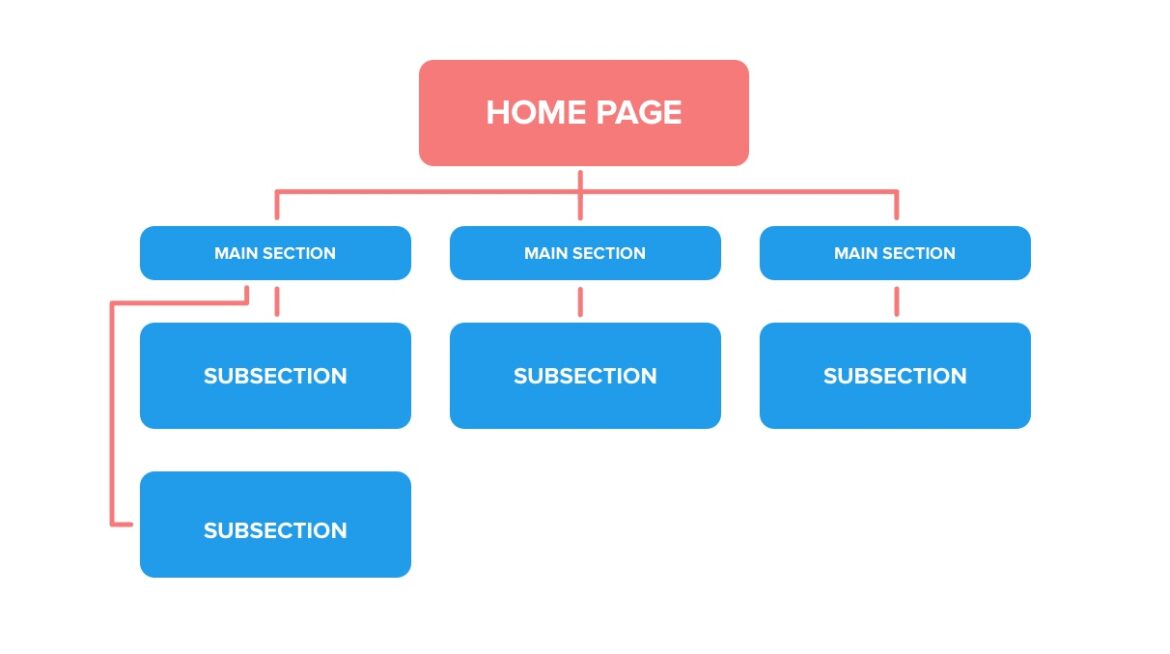
Write Engaging Copy
There are a number of ai writing tools you can use to help you get started curating your content for your audience. For your content to be worthwhile for your audience follow these steps:
- Define your target audience: Understand your audience’s needs, preferences, and pain points to tailor your copy accordingly.
- Craft compelling headlines: Grab attention with concise and intriguing headlines that convey the value of your content.
- Use clear and concise language: Keep your sentences and paragraphs concise, using plain language that is easy to understand.
- Focus on benefits: Highlight how your products, services, or content can benefit your audience to capture their interest.
- Incorporate storytelling: Engage your audience by weaving narratives or personal experiences that resonate with them.
- Include a call-to-action: Encourage visitors to take action by including clear and persuasive calls-to-action throughout your copy.
Try using Frase to come up with some ideas for your content.
Incorporating Multimedia Elements
Multimedia elements are visuals that will keep your audience engaged with your website. When this happens your audience will love your site and Google and other search engines will recognize it as what people love to consume and recommend it even more. Let’s have a look at what you can incorporate into your content to achieve this.
- Images: Use high-quality images that are relevant to your content and visually appealing. Optimize them for web use to ensure fast loading times. One of the options to implement is using nextGen image formats like WebP, Gifs etc.
- Videos: Embed videos to enhance engagement and provide dynamic content. Whether it’s product demonstrations, testimonials, or informative videos, they can add value to your web pages. Videos are usually best added from platforms like Youtube to enhance your website without affecting its speed.
- Infographics: Present complex information in a visually appealing and easy-to-understand format using infographics.
- Slideshows and Galleries: Display a collection of images or product photos using slideshows or galleries to showcase your work or products effectively.
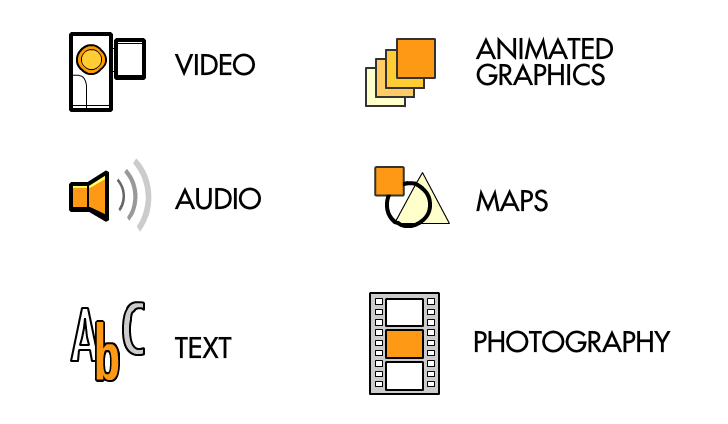
Leveraging Widgets and Third Party integrations
Integrations and widgets offered by website builders present a great way to improve your website site’s design on user-friendliness. Here are some that will make people find more interest in connecting with you.
- Social Media Integration: Integrate social media widgets to encourage sharing and increase your website’s visibility.
- Contact Forms: Use contact form widgets to make it easy for visitors to get in touch with you.
- Email Newsletter Sign-up: Add email subscription widgets to capture leads and build your mailing list.
- Maps and Location: Incorporate map widgets to provide directions or display your business location.
- Testimonials and Reviews: Display customer testimonials and reviews to build trust and credibility.
- Related Posts: Use plugins to display related or recommended posts to keep visitors engaged and encourage further exploration.
- Now that you have added content it’s time to optimize it for search engines.
4. Optimize your Content for Search Engines (SEO)
In today’s competitive online landscape, optimizing your website for search engines is crucial to ensure your target audience can find you amidst the vast sea of websites. Search Engine Optimization (SEO) involves implementing strategies that improve your website’s visibility in search engine results pages.
Let’s get into the fundamentals of SEO and look at actionable tips to optimize your website for better search engine rankings, ultimately driving organic traffic to your site.
Keyword Research:
Keyword research goes a long way in helping you reach your target audience.
- Identify relevant keywords: Conduct thorough keyword research to determine the terms and phrases your target audience is searching for. Use keyword research tools like Google Keyword Planner, SEMrush, or Moz Keyword Explorer.
- Long-tail keywords: Focus on long-tail keywords, which are more specific and have lower competition. They tend to attract more targeted traffic and have higher conversion potential.
- Keyword intent: Consider the intent behind keywords. Are users looking for information, products, or solutions? Align your content with the intent to attract the right audience.
On-Page Optimization:
On-page optimization (AKA on-page SEO) refers to all measures that can be taken directly within the website in order to improve its position in the search rankings. Examples of this include measures to optimize the content or improve the meta description and title tags. Here is how you do it:
- Page Titles and Meta Descriptions: Craft unique, compelling, and keyword-rich page titles and Meta descriptions for each page. Keep them concise and within the recommended character limits.
- URL Structure: Use descriptive and keyword-rich URLs that accurately represent the content of your pages.
- Heading Tags: Organize your content with appropriate heading tags (H1, H2, H3, etc.) to structure the hierarchy of your information and make it easier for search engines to understand.
- Keyword Placement: Incorporate keywords naturally in your content, including headings, subheadings, paragraphs, and image alt tags. Avoid keyword stuffing, as it can negatively impact your rankings.
Content Optimization:
Content optimization refers to the process of improving the quality and relevance of the content on a website. It involves incorporating relevant keywords, structuring the content effectively, and ensuring it meets the needs of the target audience.
Content optimization is important because it helps improve search engine visibility, attract organic traffic, engage visitors, and convey the intended message clearly. Here is what you need to ensure your content is optimized for search and people:
- High-Quality and Unique Content: Create valuable, informative, and engaging content that resonates with your audience. Aim for comprehensive and well-researched articles, blog posts, product descriptions, and landing pages.
- Readability: Ensure your content is easy to read, using short paragraphs, bullet points, and subheadings to improve readability.
- Internal and External Linking: Incorporate relevant internal links to other pages on your website to improve navigation and establish a logical site structure. Additionally, include authoritative external links to reputable sources to add value and credibility to your content.
- Image Optimization: Optimize your images by compressing their size, using descriptive file names, and adding alt text that includes relevant keywords.
Website Performance
Website performance refers to how efficiently a website loads and operates. It encompasses factors such as page load speed, responsiveness, and overall smooth functionality. Good website performance is crucial because it impacts user experience, search engine rankings, and conversion rates.
A fast-loading website provides a positive user experience, reduces bounce rates, and enhances overall user satisfaction. Here is how you get this done:
- Page Load Speed: Optimize your website’s load speed by compressing images, minifying CSS and JavaScript files, and leveraging browser caching.
- Mobile Responsiveness: Ensure your website is mobile-friendly and responsive across different devices. Mobile usability is a key factor in search engine rankings.
- SSL Certificate: Secure your website with an SSL certificate, which encrypts data and provides a secure browsing experience for users.
User Experience
- User-Friendly Navigation: Make sure your website has clear and intuitive navigation to help visitors find the information they need quickly.
- Mobile-Friendly Design: Optimize your website’s design for mobile devices to provide a seamless user experience across different screen sizes.
- Reduce Bounce Rate: Offer valuable and engaging content to reduce the bounce rate and encourage visitors to explore more pages on your site.
- Schema Markup: Implement structured data markup to provide search engines with additional context about your content, enhancing the visibility of rich snippets in search results.
Regular Monitoring and Optimization:
- Monitor Website Analytics: Utilize tools like Google Analytics to track website performance, user behavior, and keyword rankings. Analyze the data to identify areas for improvement and make data-driven decisions.
- Continuous Content Updates: Keep your website fresh and up to date by regularly publishing new content, updating existing content, and addressing any technical issues that may arise.
By implementing these SEO strategies, you can improve your website’s visibility in search engine results, attract organic traffic, and ultimately increase your online presence. Remember that SEO is an ongoing process, and staying up to date with the latest trends and algorithm changes is essential to maintaining and improving your search rankings.
5. Enhancing Website Functionality: Going Beyond the Basics
Now you can start adding essential elements that enhance its functionality and user engagement. By incorporating features such as contact forms, social media integration, and e-commerce functionality, you can create a more interactive and dynamic website.
Let’s explore how you can leverage these elements to engage your visitors, foster interaction, and even monetize your website.
Contact Forms:
- Add a contact form: Create a user-friendly contact form that allows visitors to reach out to you easily. Include fields for name, email address, subject, and message.
- Use form plugins: Consider using form plugins or website builders’ built-in form features to simplify the process of creating and managing contact forms.
- Set up email notifications: Configure email notifications to receive instant alerts when visitors submit a contact form, ensuring timely responses.
Social Media Integration:
- Add social media icons: Display social media icons prominently on your website, linking to your social media profiles. This allows visitors to connect with you on various platforms.
- Share buttons: Enable social sharing buttons on your blog posts or other shareable content, making it easy for visitors to share your content on their social media channels.
- Embed social media feeds: Embed live social media feeds on your website to showcase your latest posts and encourage visitors to follow and engage with you on social media.
E-commerce Functionality:
- Choose an e-commerce platform: Select an e-commerce platform or plugin that suits your needs. Popular options include WooCommerce, Shopify, and Magento.
- Set up product listings: Add detailed product listings, including descriptions, images, pricing, and variations if applicable.
- Configure payment gateways: Integrate secure payment gateways, such as PayPal or Stripe, to facilitate smooth and secure online transactions.
- Enable shopping cart functionality: Implement a shopping cart system that allows visitors to add products, review their orders, and proceed to checkout seamlessly.
Membership and User Registration:
- Create a membership system: If applicable to your website, set up a membership system that allows users to create accounts, log in, and access exclusive content or features.
- User registration forms: Implement user registration forms with fields for username, email, and password. Use plugins or website builders’ built-in membership features to streamline the registration process.
Interactive Elements:
- Incorporate interactive features: Consider adding elements like sliders, image galleries, accordions, or interactive maps to make your website visually appealing and engaging.
- Video integration: Embed videos from platforms like YouTube or Vimeo to provide additional multimedia content and enhance user engagement.
- Live chat or chatbots: Provide real-time customer support or assistance by integrating live chat or chatbot functionality on your website.
Monetization Options
- Display advertising: Explore advertising networks like Google AdSense to display ads on your website and generate revenue based on clicks or impressions.
- Affiliate marketing: Join affiliate programs and promote relevant products or services on your website. Earn a commission for every referral or sale generated through your affiliate links.
- Create and sell digital products: If you have expertise in a specific area, create and sell digital products such as e-books, online courses, or templates directly on your website.
By incorporating these enhanced features, you can create a more interactive and dynamic website that offers additional value to your visitors. Whether it’s providing easy contact options, integrating social media, enabling e-commerce functionality, or monetizing your website, these elements will help you engage your audience, foster interaction, and potentially generate revenue.
Choose the features that align with your website’s goals and target audience, and implement them strategically to enhance your website’s functionality and user experience
Mobile Responsiveness and Compatibility
- Importance of mobile-friendly design: Ensure your website is responsive and adapts seamlessly to different screen sizes. Mobile-friendly design is crucial, as an increasing number of users browse the internet on smartphones and tablets.
- Testing and optimizing for different devices: Preview your website on various devices and screen sizes to ensure proper functionality and optimal user experience. Make necessary adjustments to elements that may not display or function correctly.
- Ensuring cross-browser compatibility: Test your website on different browsers (e.g., Chrome, Firefox, Safari, Edge) to ensure consistent performance and appearance. Address any compatibility issues that may arise.
6. Launching and Publishing Your Website
The moment you’ve been eagerly anticipating is finally here – it’s time to launch and publish your website. In this section, we’ll provide you with a checklist to ensure your website is fully prepared for its debut. From testing and previewing your website to configuring domain and hosting settings, we’ll guide you through the necessary steps to confidently publish your website and make it accessible to the world.
Test and Preview your site
- Cross-browser testing: Verify that your website displays correctly on different web browsers, ensuring a consistent experience for all visitors.
- Mobile responsiveness: Test your website on various mobile devices and screen sizes to ensure it adapts flawlessly and maintains its usability.
- Proofread content: Double-check for spelling and grammatical errors to ensure a professional and polished presentation.
- Check functionality: Test all forms, buttons, links, and interactive elements to ensure they work as intended.
Domain and Hosting Configuration
- Register a domain: Choose a domain name that is relevant, memorable, and aligned with your brand. Register it through a domain registrar.
- Set up hosting: Select a reliable web hosting provider and configure your hosting account, ensuring it meets your website’s requirements in terms of storage, bandwidth, and scalability.
SSL Certificate, Search Engine Visibility, Analytics and Tracking
- Obtain an SSL certificate: Ensure the security of your website and gain your visitors’ trust by securing it with an SSL certificate. Many hosting providers offer SSL certificates or provide options to easily install them.
- Submit your website to search engines: Notify search engines about your website’s presence by submitting your sitemap through their webmaster tools (e.g., Google Search Console, Bing Webmaster Tools).
- Set up website analytics: Install a tracking code, such as Google Analytics, to monitor your website’s performance, visitor demographics, traffic sources, and user behavior. This data will help you make informed decisions to improve your website over time.
7. Maintaining and Updating Your Website
Building a website is not a one-time task; it requires ongoing maintenance and updates. In this section, we’ll discuss the importance of regularly updating your website, checking for broken links, backing up your website, and monitoring its performance. By following these practices, you’ll maintain a secure, up-to-date website that continues to meet your visitors’ needs.
1. Content Updates:
Regularly update your content: Keep your website fresh and relevant by publishing new blog posts, updating product information, and providing timely and valuable content to your audience.
Check for broken links: Use tools like Google Search Console or website crawlers to identify and fix broken links, ensuring a smooth user experience and avoiding negative SEO impacts.
2. Security and Backups:
Implement security measures: Install security plugins, update your website’s software regularly, and use strong passwords to protect your website from hacking attempts and security vulnerabilities.
Backup your website: Regularly back up your website’s files and databases to protect against data loss. Choose a reliable backup solution, either provided by your hosting provider or using a dedicated backup plugin.
3. Performance Monitoring:
Monitor website performance: Regularly check website loading speed, analyze performance metrics, and address any issues that may arise. Optimize image sizes, minify CSS and JavaScript files, and leverage caching techniques to enhance website speed.
Finally, Stay Up to Date
By consistently maintaining and updating your website, you’ll provide a positive user experience, keep your website secure, and improve its performance over time. Regularly review your website’s analytics, test new features, and seek feedback from your audience to ensure your website continues to evolve and meet the needs of your visitors.
Building a website using a website builder empowers individuals and businesses to establish an online presence without extensive technical knowledge. By following the step-by-step guidelines in this blog, you can create an attractive, functional, and optimized website that reflects your brand and engages your target audience. Embrace the world of web development and start building your own website today!
Additional resources and tools:
- The Best website builders: A comprehensive comparison of popular website builders
- SEO Basics Guide: Learn more about SEO techniques and best practices
- Web Design Inspiration Websites: Explore websites for design inspiration and creative ideas
By following this step-by-step guide, you’ll discover that building a website using a website builder is a rewarding and achievable endeavor. The power to create an impactful online presence is at your fingertips. So, let’s embark on this exciting journey together and bring your website vision to life!
